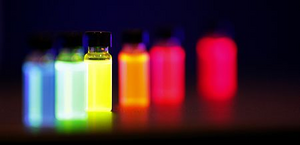Nanocrystals
Nanocrystals are particles of a crystalline nature with dimensions in the order of units to hundreds of nanometers. They have specific properties that distinguish them from bulk crystals.
Description[edit | edit source]
- They are made of metals, semiconductors and other particles that are interesting for their mechanical, chemical, electrical, optical and magnetic properties.
- They are mainly used as catalysts for chemical substances.
- They are of great scientific importance, as they form a bridge between bulk materials and atomic or molecular structures. As a result, they have some properties of bulk materials as well as molecular structures. Bulk material should have constant physical properties regardless of its size, in the case of nanocrystals it is often different.
Creation[edit | edit source]
There are several methods for the formation of nanoparticles, for example by friction or pyrolysis. In the method of particle formation using friction, macro or micro particles are placed in a ball mill or other mechanism capable of reducing the particle size. In order to obtain nanoparticles, the resulting material can then be sorted using an air stream. In pyrolysis, a vaporizable precursor (liquid or gas) is forced through a nozzle under high pressure and heated. The resulting solid (in the form of carbon black) is sorted with an air stream, recovering the oxide particles from the by-products. The result of pyrolysis is often clusters of particles rather than single primary particles.
Links[edit | edit source]
Related articles[edit | edit source]
External links[edit | edit source]
- http://ec.europa.eu/environment/chemicals/nanotech/index.htm
- http://www.czechdesign.cz/nenalezeno
- http://old.vscht.cz/ipl/nanomaterialy/Skripta/FCH_NANO_Struktura%20nanomaterialu.pdf
- novinky/index.php
Used literature[edit | edit source]
- Betty Y.S. Kim, M.D., Ph.D., James T. Rutka, M.D., Ph.D., and Warren C.W. Chan, Ph.D. Nanomedicine. The New England Journal of Medicine. 2010, 363:2434-2443December 16, 2010
Categories: Biophysics

